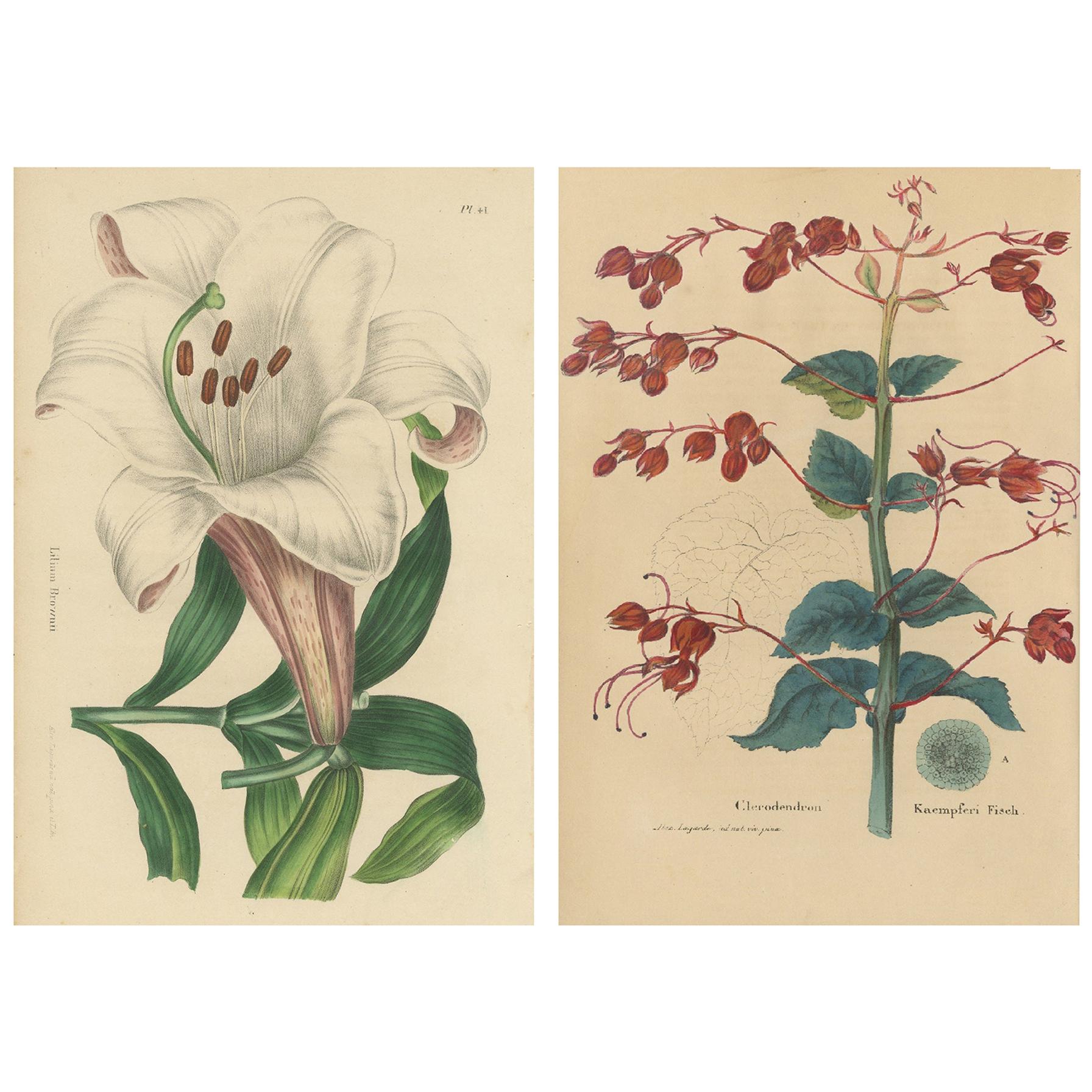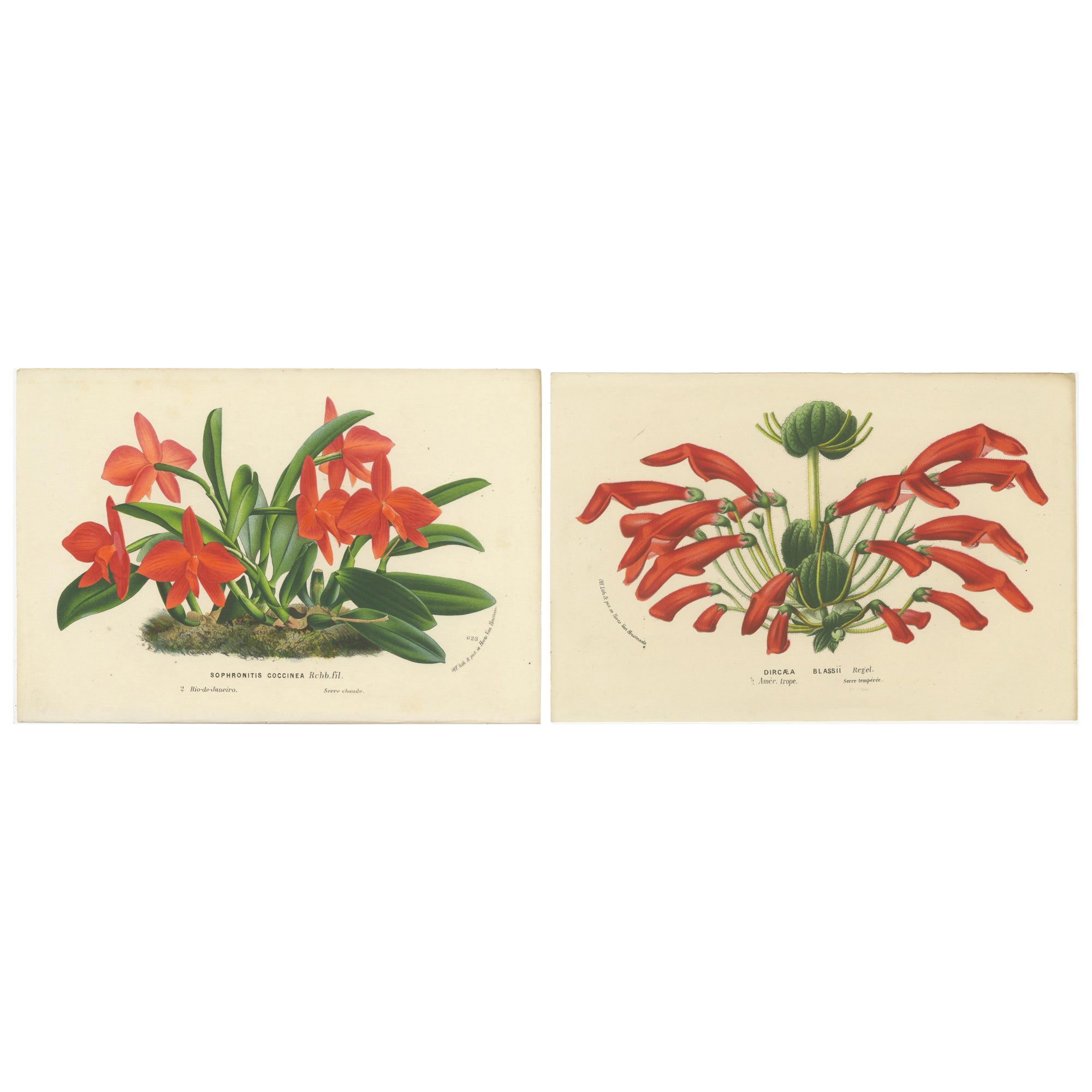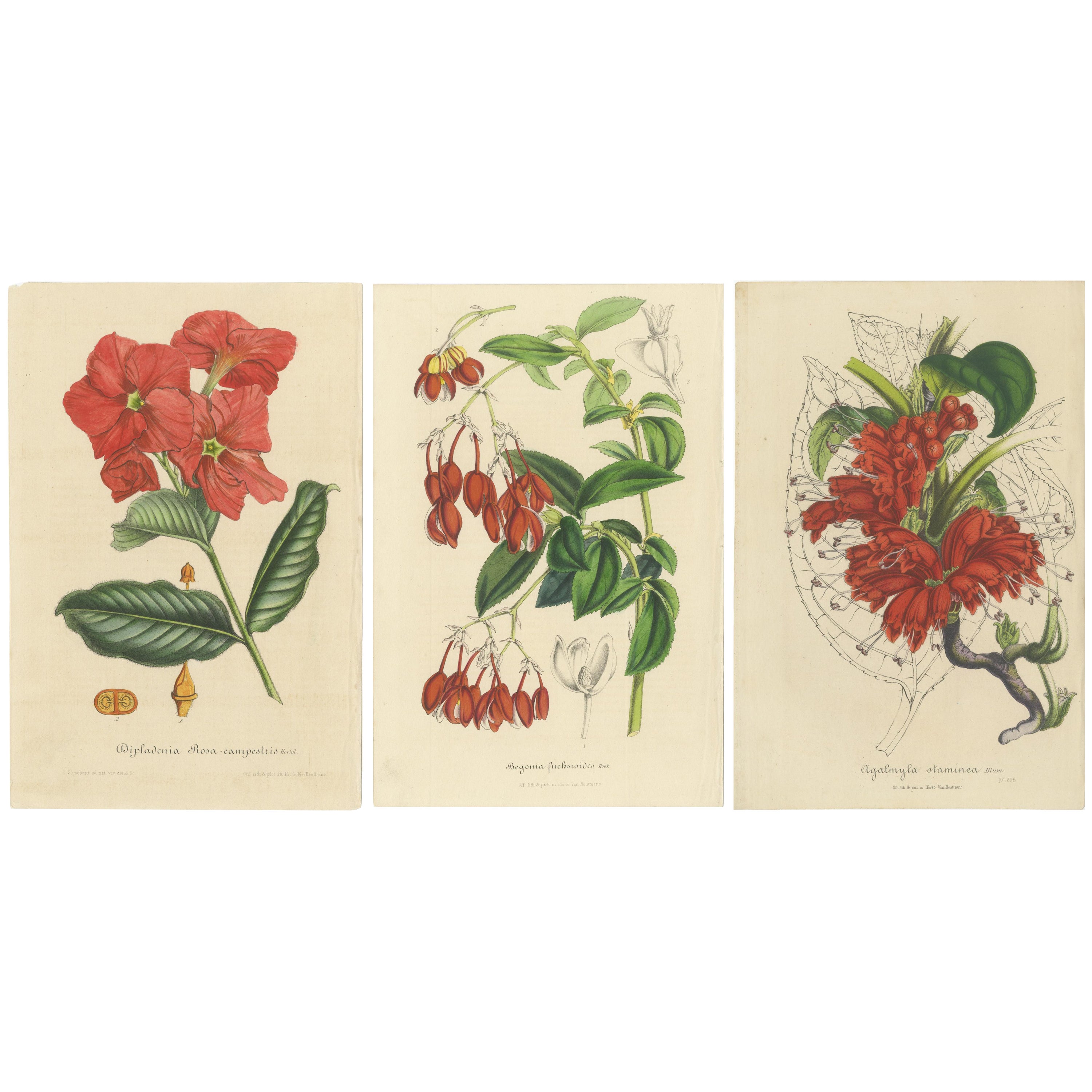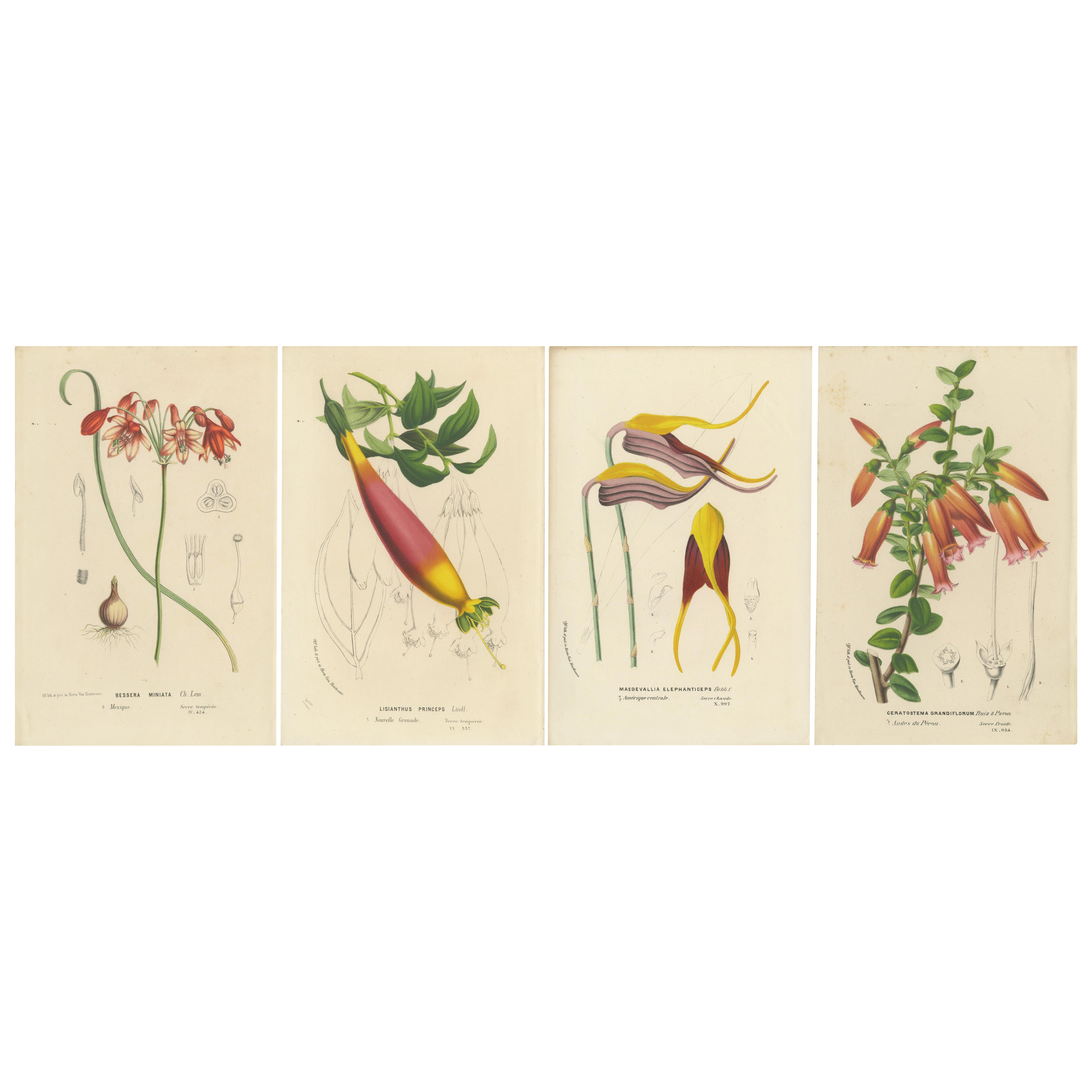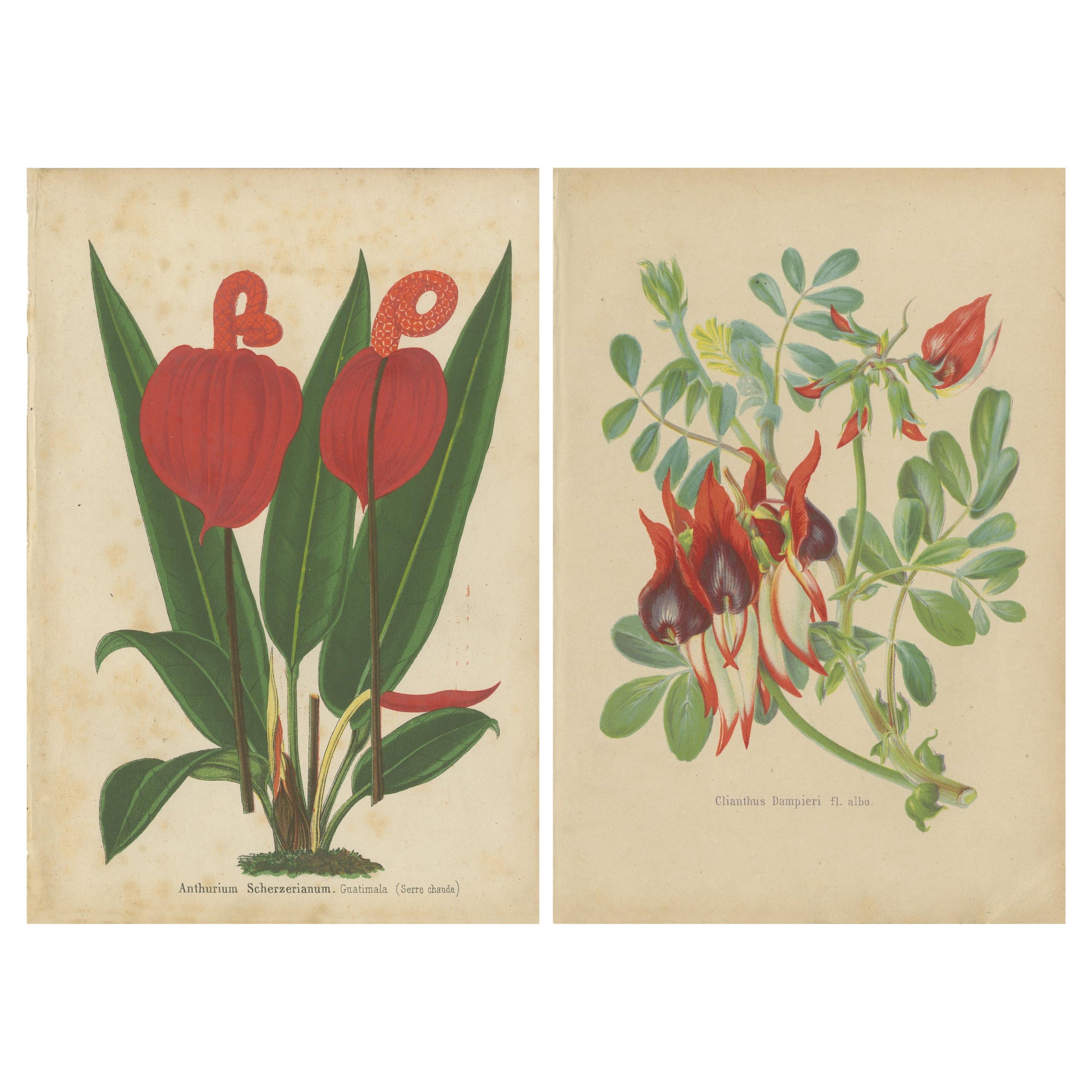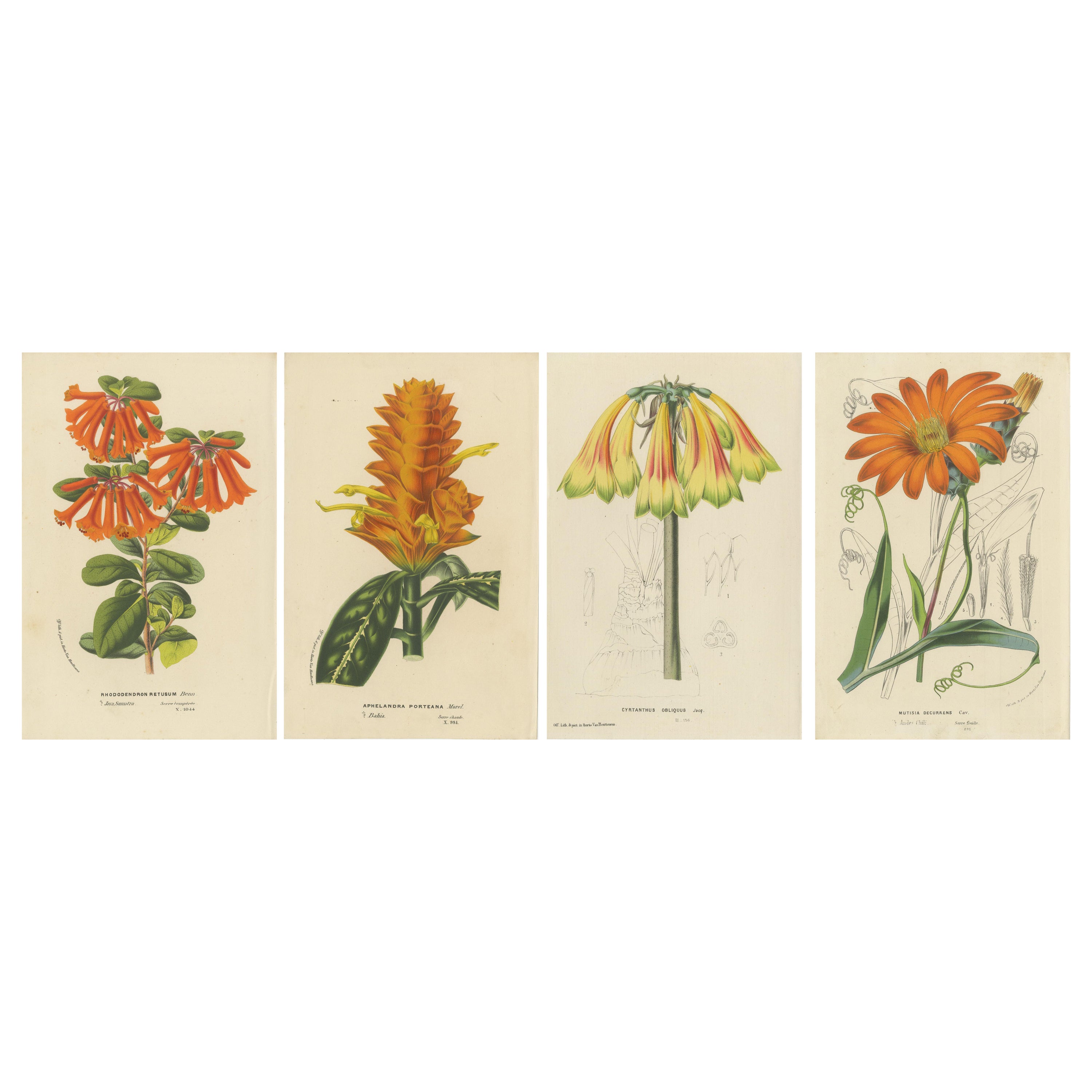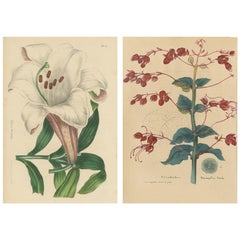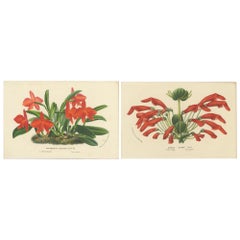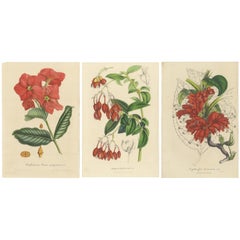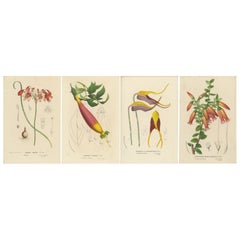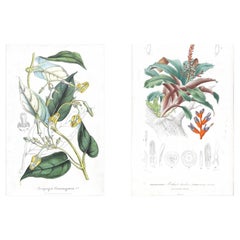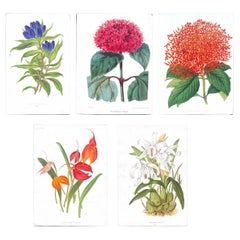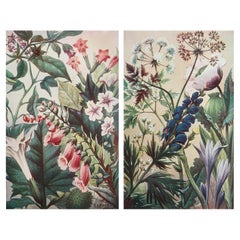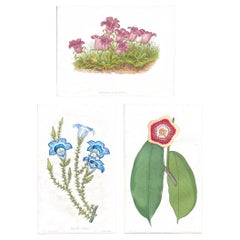Items Similar to Exquisite Flora: Natal Lily and Golden Trumpet Vine in Artistic Display, c.1855
Want more images or videos?
Request additional images or videos from the seller
1 of 8
Exquisite Flora: Natal Lily and Golden Trumpet Vine in Artistic Display, c.1855
$228.22per set
$285.27per set20% Off
£169.95per set
£212.44per set20% Off
€192per set
€240per set20% Off
CA$315.08per set
CA$393.85per set20% Off
A$349.32per set
A$436.65per set20% Off
CHF 183.58per set
CHF 229.47per set20% Off
MX$4,275.06per set
MX$5,343.83per set20% Off
NOK 2,292.72per set
NOK 2,865.90per set20% Off
SEK 2,151.95per set
SEK 2,689.94per set20% Off
DKK 1,461.82per set
DKK 1,827.28per set20% Off
About the Item
The two botanical prints are fine examples of the work from Louis Van Houtte's "Flore des Serres et des Jardins de l'Europe", which showcase the diversity and beauty of plants cultivated in European greenhouses during the 19th century. Here are the details about each plant and translations of the text:
1. Littonia Modesta
- Scientific Name: Littonia modesta Hook.
- Common Name: Climbing Lily
- Description: This plant features long, slender green leaves with tendrils that assist in climbing, and striking yellow-orange, bell-shaped flowers that dangle downwards, adding an exotic touch to any setting.
- Text on Print: "Littonia Modesta Hook. – Port Natal – Serre tempérée IX.859."
- Translation: Littonia Modesta Hooker from Port Natal, suitable for a temperate greenhouse, plate number 859 from September 1859.
2. Columnea Aurantiaca
- Scientific Name: Columnea aurantiaca Dcne.
- Common Name: Goldfish Plant
- Description: Columnea aurantiaca is recognized for its striking orange flowers which resemble leaping goldfish, making it highly ornamental. It typically grows with lush, dark green leaves that provide a perfect contrast to the vivid blooms.
- Text on Print: "Columnea Aurantiaca Dcne. – Merida – VI.532."
- Translation: Columnea Aurantiaca De Candolle from Mérida, plate number 532 from June.
Significance:
- Littonia modesta is not only a visual spectacle but also intriguing due to its climbing nature, making it a unique specimen in a temperate greenhouse setting.
- Columnea aurantiaca is particularly valued for its ornamental blooms that are highly attractive and its capability to thrive in hanging baskets, showcasing its drooping nature beautifully.
Print Technique:
- Color Lithograph: These prints were created using chromolithography, a method for making multi-color prints. This technique involves applying different colors in separate runs, allowing for intricate and vibrant illustrations. Each color layer is meticulously aligned, and the process was particularly favored for the detailed and accurate depiction it allowed, making these prints not only scientifically valuable but also works of art.
These illustrations reflect Van Houtte’s dedication to bringing the beauty of exotic and domestic plant species to the European audience, serving both as a catalog for his nursery and an educational tool for the broader public interested in horticulture and botanical sciences.
- Dimensions:Height: 9.65 in (24.5 cm)Width: 6.42 in (16.3 cm)Depth: 0 in (0.02 mm)
- Sold As:Set of 2
- Materials and Techniques:
- Period:
- Date of Manufacture:circa 1855
- Condition:Condition: Good, given age. General age-related toning and/or occasional minor defects from handling. One of the two prints has a bit more browning or foxing. Please study scan carefully.
- Seller Location:Langweer, NL
- Reference Number:Seller: BG-13761-25 BG-13761-261stDibs: LU3054341438382
About the Seller
5.0
Recognized Seller
These prestigious sellers are industry leaders and represent the highest echelon for item quality and design.
Platinum Seller
Premium sellers with a 4.7+ rating and 24-hour response times
Established in 2009
1stDibs seller since 2017
2,609 sales on 1stDibs
Typical response time: <1 hour
- ShippingRetrieving quote...Shipping from: Langweer, Netherlands
- Return Policy
Authenticity Guarantee
In the unlikely event there’s an issue with an item’s authenticity, contact us within 1 year for a full refund. DetailsMoney-Back Guarantee
If your item is not as described, is damaged in transit, or does not arrive, contact us within 7 days for a full refund. Details24-Hour Cancellation
You have a 24-hour grace period in which to reconsider your purchase, with no questions asked.Vetted Professional Sellers
Our world-class sellers must adhere to strict standards for service and quality, maintaining the integrity of our listings.Price-Match Guarantee
If you find that a seller listed the same item for a lower price elsewhere, we’ll match it.Trusted Global Delivery
Our best-in-class carrier network provides specialized shipping options worldwide, including custom delivery.More From This Seller
View AllSet of 2 Antique Botany Prints, Lilium Brownii, Clerodendrum Japonicum, '1845'
Located in Langweer, NL
Set of two antique botany prints titled 'Lilium Brownii, Clerodendron Kaempferi'. It depicts the Lilium brownii (a species of lily native to Mainland China) and the Clerodendrum japo...
Category
Antique Mid-19th Century Prints
Materials
Paper
$142 Sale Price / set
20% Off
Botanical Vintage Prints of Scarlet Sophronitis and Tropical Bloom, c.1845
Located in Langweer, NL
The prints are from Louis Van Houtte's and Charles Lemaire's "Flore des Serres et des Jardins de l'Europe," a detailed collection of botanical lithographs showcasing plants grown in ...
Category
Antique 1840s Prints
Materials
Paper
$228 Sale Price / set
20% Off
Exquisite Botanical Illustrations from Curtis’s Botanical Magazine (1847)
Located in Langweer, NL
These beautiful hand-colored botanical illustrations, drawn and lithographed by the renowned artist Walter Hood Fitch, were featured in Sir William Jackson Hooker's *"Curtis's Botanical Magazine,"* published in London in 1847. Fitch was one of the most prolific and skilled botanical illustrators of the 19th century, known for his ability to capture the intricate details and vibrant hues of the plants he depicted.
Sir William Jackson Hooker, a famous British botanist and the director of the Royal Botanic Gardens, Kew, commissioned these illustrations as part of his work to document newly discovered plants from around the world. The *Curtis’s Botanical Magazine* has been published since 1787 and remains one of the longest-running botanical periodicals.
Detailed Descriptions of Each Plant
#### 1. **Dipladenia Rosa-campestris** (*Hortul. ex Veitch*)
- **English Name**: Rose Dipladenia
- **Description**: This illustration showcases *Dipladenia rosa-campestris*, a striking flowering plant known for its showy pink to deep red trumpet-shaped flowers. Native to tropical regions of South America, particularly Brazil, *Dipladenia* belongs to the family Apocynaceae and is prized in horticulture for its vibrant blooms and ability to climb. Fitch's illustration emphasizes the waxy leaves and the vivid color of the petals, bringing the plant to life on the page.
#### 2. **Begonia fuchsioides** (*Hook.*)
- **English Name**: Fuchsia-flowered Begonia
- **Description**: The *Begonia fuchsioides* is depicted with its characteristic red, pendulous flowers, which closely resemble the blooms of fuchsia plants. This species of Begonia is native to tropical regions and is popular for its delicate, bell-shaped flowers and glossy leaves. Fitch’s attention to the arrangement of the leaves and the contrast between the flowers' vibrant red and the soft green leaves provides a lifelike representation of this exotic plant.
#### 3. **Agalmyla staminea** (*Blume*)
- **English Name**: Staminate Agalmyla
- **Description**: This illustration captures the unique red tubular flowers of *Agalmyla staminea*, a plant native to Southeast Asia. The species is part of the Gesneriaceae family and is known for its bright, showy flowers that grow in dense clusters. Fitch’s careful rendering of the plant’s leaves and the intricate veining, along with the vibrant red flowers, highlights his talent for bringing the botanical subject to life with both scientific accuracy and artistic flair.
### About the Makers
#### **Walter Hood Fitch** (Artist and Lithographer)
Walter Hood Fitch (1817–1892) was one of the most influential botanical artists of the 19th century, working primarily with Sir William Hooker and later his son, Joseph Dalton Hooker, at Kew Gardens. He produced thousands of illustrations for various botanical publications, including *Curtis’s Botanical Magazine*, where he was responsible for the majority of its plates from 1834 to 1877. Fitch’s mastery of lithography allowed him to create richly detailed and accurate depictions of plants, with a particular talent for illustrating both the botanical structure and the vibrant colors of flowers.
#### **Sir William Jackson Hooker** (Director and Editor)
Sir William Jackson Hooker (1785–1865) was a prominent British botanist and the director of the Royal Botanic Gardens, Kew. Under his leadership, Kew Gardens expanded its collection of plants from around the world, and Hooker was instrumental in promoting the scientific study and illustration of these species. As the editor of *Curtis’s Botanical Magazine*, Hooker collaborated with Fitch to document and share the beauty and diversity of plants with the scientific community and the public.
### The Lithographic Technique
Lithography, particularly chromolithography, was a crucial innovation in botanical illustration. Fitch was skilled in the traditional method of lithography, where an image was drawn onto a stone plate with a greasy substance and then inked for printing. Hand-coloring was often applied afterward to bring the prints to life, as seen in these illustrations. This method allowed for highly detailed, accurate representations of plants and their botanical features, making it invaluable for both scientific study and aesthetic appreciation.
### Conclusion
These prints from *Curtis’s Botanical Magazine* reflect the height of botanical art in the mid-19th century. The combination of Walter Fitch...
Category
Antique 1840s Prints
Materials
Paper
$408 Sale Price / set
20% Off
Floral Collection: Coral Drops, Prairie Gentian, Monkey Orchid, Bellflower, 1875
Located in Langweer, NL
"Elegant Flora: A Showcase of Bessera, Lisianthus, Masdevallia, and Ceratostema"
This title emphasizes the elegance and distinctive characteristics of each species, enhancing the bo...
Category
Antique 1870s Prints
Materials
Paper
$361 Sale Price / set
20% Off
Vibrant Botanical Lithographs: Flamingo Flower and Sturt's Desert Pea, c.1855
Located in Langweer, NL
Description of the Combined Lithographs
Left Image: Anthurium Scherzerianum
This lithograph features the Anthurium Scherzerianum, commonly known as the Flamingo Flower or Laceleaf,...
Category
Antique 1850s Prints
Materials
Paper
$114 Sale Price / set
20% Off
Vibrant Botanical Portraits: Exquisite Plant Illustrations from the 19th Century
Located in Langweer, NL
These illustrations, executed with precision and rich coloration, are fine examples of chromolithography, a technique popular in the 19th century for its ability to produce vivid, mu...
Category
Antique 1870s Prints
Materials
Paper
$361 Sale Price / set
20% Off
You May Also Like
Set of Two Rare Botanical Engravings by D’Orbigny — 1849
Located in Fukuoka, JP
Set of Two Rare Botanical Engravings by D’Orbigny — Dictionnaire Universel d’Histoire Naturelle, Paris, 1849
An exquisite pair of original hand-colored botanical engravings from the...
Category
Antique 19th Century French Prints
Materials
Paper
Bignonia venusta – Antique Botanical Chromolithograph, 1880s
Located in Fukuoka, JP
A striking original botanical print from the 1880s, featuring Bignonia venusta, also known as flame vine or orange trumpet vine. This brilliantly colored illustration captures the dr...
Category
Antique 19th Century French Prints
Materials
Paper
Pair of Original Vintage Botanical Prints, circa 1900
Located in St Annes, Lancashire
Great images of medicinal plants
Unframed.
Published, circa 1900.
Free shipping
Category
Antique Early 1900s English Edwardian Prints
Materials
Paper
Campanula Allionii – Original Antique Botanical Print, France, 19th Century
Located in Fukuoka, JP
Hand-colored lithograph from the 1800s
A finely detailed and richly colored 19th-century botanical print depicting Campanula Allionii, a charming alpine bellflower native to the sou...
Category
Antique 19th Century British Prints
Materials
Paper
Lapagerias & Passiflora, English antique flower botanical chromolithograph, 1896
Located in Melbourne, Victoria
'Lapagerias and Passiflora'
Flowers are numbered with a key to the varieties below the image.
Antique English flower botanical chromolithograph.
Category
Late 19th Century Naturalistic Still-life Prints
Materials
Lithograph
Antique Botanical Plate Boehmeria tenacissima Bohemian Manufacture of the 1930s
Located in Milan, IT
Colored lithograph applied on light cardboard depicting botanical study with various sections of Boehmeria tenacissima Roxb and of Corchorus capsularis L. Bohemian manufacture of the...
Category
Vintage 1930s Czech Prints
Materials
Paper
More Ways To Browse
Cobalt Blue Porcelain And Bronze Urn
Crab Claw
Crockery Cabinet
Crystal Cat Vintage
Danish 3 Chest Of Drawers
Decorative Crafts Inc Brass
Delft Large Jars
Discus Thrower
Double Pendulum
Dovetail Vinyl Record
Dragon Boat
Drexel Chinoiserie
Drexel Precedent
E Drouot
Edward Wormley Precedent
Egyptian Cat
Embossed Copper Box
English Bow Front Chest
